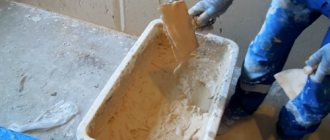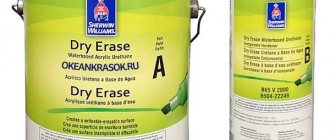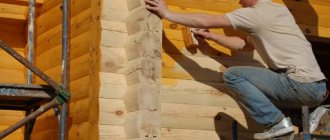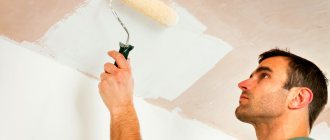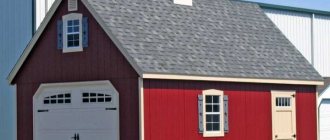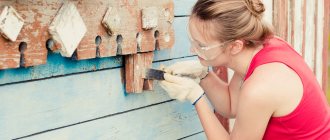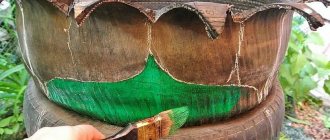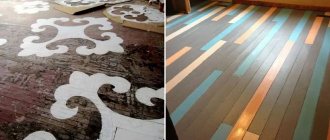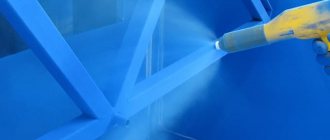Despite the popularity of plastic double-glazed windows, many homeowners prefer traditional wooden windows. Such structures, in comparison with plastic ones, have many advantages: they are environmentally friendly, safe, and most importantly – very durable. However, wooden windows require constant care. Over time, the paint layer and protective impregnations wear off and require replacement. The right paint for wooden windows will help maintain the color of the window frame and its integrity for a long time.
What paint to choose for wooden windows
Novice craftsmen often do not know what paint is best to paint wooden windows. The wood coating must have the following characteristics:
- increased resistance to moisture, pests and fungus;
- elastic structure that can withstand expansion from moisture;
- a breathable, porous surface that will allow air into the room.
These paint characteristics will not only extend the life of the windows, but also improve their performance. Knowing the characteristics of different materials will help you figure out which paint to choose for painting wooden windows.
Paint for wooden windows: what is it and what is it needed for?
This is a paint and varnish material created specifically for application to wooden surfaces, including structural elements of window systems. The key features of any paint are:
- Creating a protective film on the surface of wood. After hardening, the coloring composition turns into a dense film that is resistant to environmental influences. Thus, painting helps protect the wood and extend the life of the windows.
- Painting the structure in the required shade. Very often, owners of wooden windows need to paint them one color or another. This may be required to give the window structure a certain style, for example, so that it can harmonize with the exterior of the building or the interior decor of the room. Modern paints allow you to paint windows in a wide variety of colors and shades.
It is worth noting that there is also a colorless type of paint for wooden windows. The peculiarity of such materials is that they practically do not change the natural color of natural wood, allowing it to remain just as beautiful and attractive.
| Buy paint for wooden windows |
| 8 (495) 995 40 39 |
Paints and varnishes for interior and exterior window decoration
Alkyd paints are usually used indoors. They have an elastic structure and give the windows an aesthetic appearance. The flexible structure of the coating is achieved thanks to oil inclusions.
For outdoor work, more durable coatings are required, such as acrylic and nitro paint. Such paints and varnishes dry very quickly, and they do not have a strong odor, and after drying, a durable film is formed on the window frame. However, paints are not suitable for window sills. You can figure out how to paint wooden windows only by taking into account the characteristics of different materials.
Read more about suitable paints
When thinking about how to paint wooden windows on the outside, the choice is usually made among the following options presented.
As you remember, the composition can be a certain color or transparent. Will not dwell on this. It’s better to tell you about the varieties presented above.
- Water-dispersed
. These compositions are made on the basis of aqueous polymer dispersions. They have high performance indicators. Works well on wooden windows, as well as other wooden surfaces. The mixture is not afraid of ultraviolet radiation. Does not ignite and does not emit unpleasant odors; - Oily
. Consist of natural materials, including oils and resins. Due to this, it is possible to achieve decent operating parameters. Oil paint will resist water and moisture especially well. But it takes a long time to dry. When working outside, it is advisable to protect the window until it dries completely. Plus it fades faster in the sun. Suitable for a dacha. For a private house where you live permanently, this is not the best solution. Although it is budget; - Alkyd
. A worthy option for processing wooden structures. The outside of windows is no exception. Well resists attacks from atmospheric phenomena. But before use you need a special solvent. This is a two-component paint; - Acrylic and polyurethane
. There is another option using acrylic and polyurethane paint. They perfectly withstand unfavorable environments. Organic solvents in the composition provide high strength. In terms of durability, polyurethane compounds win. The most wear-resistant. The best choice for exterior decoration. Acrylic is diluted with water. They cost less, but are slightly inferior in characteristics; - Nitrocellulose
. The last, but definitely not the worst option for painting wooden windows on the outside. But you must work strictly in protective masks or respirators. The composition is highly flammable.
These are the paint options available for outdoor use.
Universal paint
If you want to save money on painting wooden windows, purchase universal paints. Such coatings can be used for both interior and exterior work. Universal paints and varnishes include atmospheric glossy enamel.
When purchasing a coating, pay attention to its resistance to temperature changes and precipitation. In the realities of the Russian climate, it is recommended to use alkyd enamels and water-based acrylic coatings.
Types of wood paints, what to choose for a wooden frame
Alkyd, oil and acrylic paint compositions are suitable for processing wooden elements of window structures. Each paint material has pros and cons.
Acrylic
Paint with polymers and water base. The advantage of the material is the absence of a strong odor and environmental friendliness. The polymers included in the composition ensure the resistance of the painted surface to sunlight and atmospheric influences. The service life of acrylic paint is about 7 years; freezing and humidity of the painted structure are not a problem. The acrylic composition is easy to apply, the average drying time is a couple of hours. There is no need to remove the old coloring material - this is another plus. Consumption – up to 150 g. per sq. m.
Alkyd
Alkyd paint is based on pentaphthalic or glypthal varnish. A freshly painted surface takes a day to dry, and the paintwork has a strong smell. The toxicity of the solvent (solvent, white spirit) requires the use of protective equipment during work. The layer is elastic and can withstand temperature changes. The coating repels water, which is important for wooden window structures. If you paint window frames with alkyd paint, the wood will be protected from insects and fading. The service life of paintwork materials is 5 years; after cracking, renewal is required. The advantage of alkyd coloring composition is color variety. On sale, the material is already tinted. Consumption – up to 180 g. per sq. m.
Pay attention to: How to paint antique forged items: choice of material, technology for aging metal products
Oily
Drying oil-based paint is a mixture of pigments. Painted windows will be protected from water, chemicals, and the destructive effects of direct sunlight. Negative temperatures are also not dangerous for the coloring composition. The material can be diluted with drying oil, white spirit is suitable, but its amount should not exceed 5% of the paint volume. The service life is short (up to 3 years), the drying time of the layer can be up to two days. Fire hazard and pungent odor are the disadvantages of oil paints.
Acrylic paint
Alkyd enamel
Oil paint
Characteristics of various paints
In addition to the above coatings, oil, enamel and adhesive paint compositions are used to paint wooden windows. To decide which paint to use in your home, compare all the climate characteristics: humidity, precipitation and temperature differences. It is also important to consider the condition and type of wood being painted.
Polyurethane and acrylic coatings
Acrylic and polyurethane based paints are considered the most resistant to adverse conditions, especially moisture. Such coatings contain toxic organic solvents, which make the composition durable. Among these two types of paints, polyurethane paints are more durable and extremely wear-resistant, which is why they are recommended for use in exterior decoration. However, polyurethane paints have one drawback - high cost. In this regard, acrylic ones are inferior to them, which is why they are more popular among novice craftsmen. It is also important that acrylic coatings can be diluted with water and mixed with pigments to obtain complex shades. However, white paint is most often chosen.
Alkyd paints
Today, alkyd paints are increasingly being chosen. In addition to resistance to weather conditions, this type of coating has another advantage - it can withstand treatment with aggressive detergents and oils. The paint composition applied to the primed surface can last up to 5 years. Such paint can withstand temperatures from plus 60 to minus 50. This paint is good for application to coatings located outdoors.
Nitrocellulose window coverings
Nitrocellulose paints are also suitable for treating wooden window frames. The only feature that is worth remembering when using such coatings is the mandatory active ventilation of the premises during operation and drying. The paint contains acetone, which releases vapors after application. In addition, the paint burns very easily, so it should be stored away from sources of ignition. White coatings are very popular.
Increasingly, homeowners are coating their window frames with transparent compounds. Varnishes perfectly protect wood and allow you to admire the natural structure of the material. The composition of transparent varnishes is identical to alkyd enamels, with only one difference - coloring pigments are not added to the varnishes. Choosing such a material is the best solution if you want to preserve the texture of the wood. The main condition is that the selected material must meet the operating conditions.
Which paint is better
The material must be moisture resistant to protect surfaces from fungus and mold.
For painting old wooden windows, plastic and elastic compositions are optimal, which will not crack when the structure swells or dries out. The breathability of the composition, resistance to mechanical damage, and durability are also important. Wooden windows are painted with acrylic and polyurethane compounds, alkyd and oil dyes. The color scheme of the material depends on the design project. Shades can be any, but there are also universal ones (white, beige, ivory, dark brown, etc.). It is possible to preserve the natural structure of wood and color using transparent and translucent varnishes, impregnations and solvent-based stains.
Polyurethane and acrylic coatings
Acrylic and polyurethane enamels and varnishes are the most technologically advanced, advanced compositions. Due to organic solvents, the materials are strong, wear-resistant, and durable. Structures should be painted in ventilated areas, as they have a strong odor and toxic fumes.
Polyurethane enamels are considered the most stable, providing a reliable coating for wooden frames. But the composition has a high price, so budget acrylic dyes are in demand for mass use. The material dries quickly, is durable and resistant to mechanical stress. Acrylic can be diluted with water to the desired shade of tinting.
Alkyd paints
Alkyd compositions are resistant to atmospheric influences, temperature changes, and tolerate cleaning with chemical detergents. Before properly painting the window frame with an alkyd composition, it must be primed. After surface treatment, the paintwork will last up to 4 years without restoration.
Alkyd paint, cost 880 rub.
The paint is resistant to high temperatures in summer (up to +60°C) and low temperatures in winter (down to -50°C), so the treatment of internal and external frames is optimal. Oils are added to alkyd enamels to increase elasticity, aesthetics, and strength.
Nitrocellulose window coverings
Nitrocellulose enamels are suitable for painting external frames. The materials dry quickly, are durable, and aesthetically pleasing. Nitrocellulose paints and varnishes contain cellulose ether nitrates (in solvents and thinners). The quality and elasticity of paint is enhanced by alkyd resins and plasticizers. The disadvantages of this type of finish include the increased flammability of nitrocellulose enamels and varnishes, as well as limited chemical and atmospheric resistance.
Do-it-yourself painting of wooden windows
Before processing a wooden frame, you need to understand that different species require different work:
- oak does not require moisture impregnation, but they need to be protected from woodworms and other pests;
- pine absorbs moisture well, so it simply needs treatment against water and pests;
- Larch, unlike oak and pine, is resistant to both pests and moisture, so it does not need impregnation.
It is recommended to impregnate any wood with fire retardants, this will increase the safety of structures.
Paint selection
- The penetration of moisture into the interior of a wooden frame can sometimes lead to irreversible processes: putrefaction, mold formation and even destruction, which, undoubtedly, can harm both your health and budget. Therefore, when choosing paints and varnishes, you should give preference to moisture-resistant ones.
- Another important requirement for painting materials for window frames is their elasticity. Only then will the paint layer remain intact during the process of typical wood deformations - shrinkage and swelling.
For reference!
When choosing paint, mainly focus on two parameters: the type of wood from which the frame is made, and the climate in the area.
- For mild climates, oil paint is the best solution.
- Old wooden window frames are painted using glossy enamel, which is weather-resistant. It is suitable not only for outdoor use, but also for indoor use, that is, it can be considered a universal material.
- “Weak” wood species that are not resistant to atmospheric influences are additionally protected with a layer of varnish.
- Painting wooden frames using alkyd paint protects the wood from the destructive effects of sudden fluctuations in temperature, moisture, and more. This coating is elastic and durable, has high decorative characteristics, and is easy to maintain - it can simply be washed using almost any detergent composition.
- To paint the surface of the flashings on the outside and inside, you can use different compositions. For example, alkyd paint is suitable for interior painting, and acrylic paint for exterior painting.
The rules for choosing paint colors are quite simple:
- for window systems on the sunny side, a light one is suitable, then it will not absorb the rays of the sun, but, on the contrary, will reflect it, and the frame will not dry out for a long time;
- those facing the shadow side can be painted in dark colors.
Painting tools
Before any work, you need not only to buy a high-quality coating, but also to prepare all the tools. If you don’t know how to paint wooden windows with peeling paint, start by preparing the surface. To do this, the coating is sanded and small nails, chips and other protrusions are removed. The working surface should be as flat as possible. For work you will need the following tools:
- pliers, cutters and other devices for removing screws and nails;
- spatulas and sandpaper to remove paint if it has peeled off;
- When disassembling, be sure to remove the glazing beads; to secure them after cleaning, you need a hammer;
- for small frames you will need brushes, for large ones you can use rollers;
- containers or cans for paint;
- To remove glazing beads, a nail puller is needed; it is also used to remove the sashes;
- You will also need putty and a spatula for it; the composition is used to treat dents and chips of old frames;
- antiseptic composition for wood processing;
- solvent for removing paint from brushes and glass.
When treating windows with acrylic paint, color or pigment is often used. With their help, you can give the composition the required shade; it is recommended to buy ready-made colors, since not everyone can do the tinting the first time. To find out what kind of paint to use on wooden windows, here are some tips and tricks.
Materials and tools for painting windows
Before you paint old wooden windows with your own hands, you need to prepare the necessary materials. Carefully check whether you have everything and, if necessary, buy additional things that are missing. To paint a wooden frame you will need the following tools:
- manual and electric grinding machine;
- scraper;
- putty knife;
- foam roller;
- small brush;
- construction tape;
- paint container;
- hammer, screwdriver, nails;
- old rags and newspapers.
You will also need to purchase materials such as:
- wood primer;
- putty for wood;
- solvent;
- White Spirit;
- paint.
Don't forget to purchase White Spirit.
Additionally, prepare a stepladder or stool to reach the top of the window. It will not be superfluous to take care of means of protection against harmful fumes. These could be special glasses, a respirator or medical mask, gloves, old clothes, which if you get them dirty, you won’t mind. You will also need a piece of plastic film to cover the space under the window and not splatter everything with paint.
Helpful Tips and Tricks
It is very important to choose the right time for painting work, this will ensure excellent adhesion of the paint to the wood. It is optimal to paint windows on a warm, not very sunny day (as ultraviolet radiation destroys paint pigments). It is best if there is low humidity on this day. For most paints, the optimum humidity is less than 80 and the temperature is above 5 degrees, but even under these conditions the coatings dry perfectly.
It is not recommended to apply paint to a new frame that has just been purchased, or to a product that is wet from rain. This will cause the coating to bubble, which will peel off after drying.
Advice! It is better to paint wooden windows from the outside. Thanks to this, you can keep the room clean.
Also, the paint can peel off due to a poor base and unfavorable indoor conditions. It is recommended to carry out wet cleaning to remove dust and dirt at the place where painting will be done. You should also learn how to remove the old coating.
Method for removing old paint
Before applying the coating to the old frame, you need to remove the first layer of paint; to do this, use the following technology:
- The window frame is heated with a hair dryer or blowtorch. A layer of coating that is not very old will quickly begin to bubble, which will allow you to remove all the paint with a spatula. If this method does not work, you will have to soak the frame with solvent and remove the paint with scrapers and spatulas.
- It is important to prepare the frame itself; it should be smooth and easy to close. If there are problems with slamming, it is necessary to grind off the unevenness that prevents closure. For such work, grinding equipment is used. Cleaning the coating is done carefully, otherwise the wood layer may be damaged.
If you cleaned the paint with a solvent, be sure to thoroughly dry the frame after the procedure.
To understand how to clean wooden windows from old paint, you should use not only solvents, but also special liquids for removing old coatings. Similar substances can be purchased at a hardware store. To remove paint, apply liquid to the surface and wait until the paint turns into lumps. The resulting mass can be easily removed with a spatula or a stiff brush. This cleaning will ensure ease of subsequent work.
Preparing a window for painting
In order for the frame to look neat after applying paint, it is necessary to remove all fittings, the doors themselves, and protect the glass before painting. If latches and hinges are faulty, they are repaired and replaced. Locks and handles that cannot be removed are simply wrapped with masking tape to protect them from paint. This will avoid unnecessary cleaning.
In addition to fasteners and handles, glass sheets also need to be prepared for painting. Most often, white paints and varnishes are used for coating, which after drying are very noticeable on the glass. Therefore, even before mixing the paint, the joints of the frame and the glass are sealed with wide masking tape on both sides. For novice craftsmen, it is better to cover all the glass with newspapers. We paint the frames carefully so as not to create unnecessary work for ourselves.
Note! The adhesive tape is not attached to the frame tightly, but with an indentation of 1.5-2 mm. This distance will allow the paint to penetrate into the cracks of the frame, thereby protecting the wood from destruction and from moisture accumulation.
It is not recommended to use old glazing beads for glass on old frames. Such structures wear out quickly, so it is better to replace them with new ones. To prepare, new glazing beads are sanded, coated with primer and paint. After drying, they are nailed to the frames. We choose high-quality coating materials so that after a while we do not have to replace some elements with new ones.
Preparing wooden windows for painting
In order for wooden frames to last longer, it is necessary to choose the right time for painting. The ideal condition for repair is a warm day without bright hot sun, when the humidity is low and ultraviolet radiation does not destroy the structure of the paint. Wooden frames dry well at temperatures above 5C and relative humidity below 80%. You should not apply paint to a wet surface, because... Later, bubbles may appear on it, and you will have to repaint the frame. Paint peeling also occurs due to dampness or poor pre-cleaning.
Preparing a window for painting
Let's take a closer look at how to paint windows and wooden frames in a frame house. The first thing you need to do is remove the old layer of paint. For this work, use a scraper and coarse sandpaper. If you have problems closing the frame, use a sander to smooth the surface. Use the machine carefully so as not to damage the wooden base of the frame.
Remover for removing old paint
Currently, special liquids for removing the old layer of paint have appeared on the construction markets, such as Tikkurila, Shostka, Svema, etc. This significantly speeds up the process of preparing wooden frames for repair. This mixture is applied to the frames, and when the paint wrinkles and turns into a cheesy substance, it is scraped off with a spatula and the surface is treated with coarse sandpaper.
It is better to remove wooden window sashes and all fittings before painting so that the window looks neater after painting . If it is not possible to remove the handles or locks, simply cover them with masking tape.
We also carefully and accurately prepare all window glass. It is necessary to cover all the glass with newspapers, securing them with tape on the sides, retreating 2 mm from each edge, so that the paint gets into the narrow cracks and does not allow moisture and water to accumulate in the future. Throw away the old glazing beads, paint the new ones separately from the wooden frames and nail the finished ones.
The process of puttying and priming wooden windows
Carefully inspect the wooden frame. Pre-treat all parts and elements that may rust over time and ruin your repair with a primer specifically for iron (nail caps, metal hinges, etc.).
Antiseptic is an important part of the preparatory work before painting frames. This treatment will prevent wood rotting, the development and formation of fungus, and will not allow insects to settle in your wooden house. Impregnation will make your frame last longer.
After treating the frame with an antiseptic, we inspect the surface of the window. All cracks, undulations or potholes must be filled. But do this gradually, because too thick a layer of putty may fall off along with the paint layer, and you will have to start the repair again.
You need to choose a special putty for wood, based on acrylic; it usually comes in cans of 200 g. If we paint wooden frames, then apply the putty in a regular layer to the surface. If we cover wooden frames with stain, all the putty areas will be visible through it, so the putty must be tinted to match the color of the wood.
You can prepare this finishing material yourself from wood flour, glue or epoxy resin.
After applying the first layer of putty, you need to clean the surface with sandpaper. After a few hours, when the second layer has dried well, we once again smooth the entire surface of the frame with sandpaper. The process must be repeated until the surface of the wooden frame is perfectly smooth.
The next stage is the primer. This process will ensure reliable and high-quality coating of wood with paint. Modern primer mixtures are also an antiseptic. When applied, it forms a protective transparent film, which is necessary to preserve the natural grain of the wood. In addition, primer mixtures protect well from mold, dampness and fungi, and do not allow rotting processes to develop on the outside of the frame, even with increased humidity.
Window primer
The primer consists of the following elements: oil, resin, glue, and various pigments. The recipe for each primer mixture is significantly different, but what all wood primers have in common is their ability to preserve the natural structure of wood. Therefore, metal primer is not used for wooden parts.
Before priming the surface, it is necessary to thoroughly degrease it with white spirit. It is better to prime with a brush rather than a roller. If the putty did not dry very well or you missed an area when priming the surface, a dark spot may form in this area after painting.
Why do you need putty?
Adherents of old technologies use a mixture of rosin, wax and turpentine for priming. Today, such compositions have become obsolete and are rarely used. Construction departments are full of a variety of primers, putties and other compounds intended for painting. Most often, acrylic materials are used to prime the surface of wood. Applying putty includes the following steps:
- The frame is inspected for damage. If metal parts are worn out or have cracks or areas of rust, they are treated with a metal primer.
- Before applying the primer, the surface of the wood is impregnated with an antiseptic. This measure will protect the array from beetles and rot, which will significantly extend the service life of the structure.
- After applying the antiseptic, the frame is re-inspected. Antibacterial impregnation will not cover serious cracks and chips; these are the ones that need to be covered with putty. The procedure is performed in stages, filling the cracks over and over again. If you put a large layer of material on the wood, it will fall off along with the paint.
- If the cleaned window frame is planned to be painted, then the putty is applied in a middle layer (the material will not be visible under the white paint). For processing under varnish and stain, the putty is tinted to match the color of the solid wood. You can also make your own putty composition from epoxy resin and wood fibers.
- First, apply the composition on the chips in one layer and wait for it to dry. After this, the layer is cleaned of nicks and protrusions.
- After drying, apply a second layer and also clean it.
- The procedure is carried out until the frame becomes level.
Note! Before applying a primer for a specific coating, the surface is degreased with a solvent. It is recommended to apply the primer with a roller as this provides a more even surface.
Instructions for painting a wooden window
Painting wooden windows assumes that the type of wood from which they are made is taken into account when choosing paintwork materials and processing methods. If the frames are made of pine, then they need to be impregnated with protective compounds (from insects, from moisture). Oak structures tolerate wet conditions, but are threatened by insects. Larch is preferable as a material for window frames because it does not require processing (similar to pine) and is not afraid of insects.
Materials and tools
To paint window frames you will need:
- pliers, screwdriver - for removing fasteners (screws, nails), removing accessories;
- spatula to remove the old layer and apply putty
- industrial hair dryer - the heated old layer will come off better;
- a small hammer for nailing new glazing beads;
- sandpaper for wood processing;
- masking tape (other covering material) to protect slopes;
- brushes (the width of the frame will determine the size);
- containers for paints and varnishes;
- putty;
- antiseptic to protect wooden structures from mold;
- solvent for paints and varnishes;
- color (if using white acrylic paint);
- sieve for straining.
Painting tools
Do it before work
If the windows are wooden, a number of factors need to be taken into account when preparing for work. Suitable conditions for painting are no scorching sun, low humidity. The frames themselves must be dry, since when applying paint over a wet structure, bubbles will appear and the overall appearance will be spoiled. When working indoors, you need to carry out wet cleaning. Dust settling on the frames will impair the adhesion of the paint layer.
How to remove old paint
Before painting wooden windows, you need to remove the old layer of paint. If a hair dryer does not help, you will have to clean the frame with a spatula and coarse sandpaper. Sometimes a solvent may be needed. An alternative cleaning option is to use paint strippers. Old paintwork combined with a swollen frame leads to jamming. Rubbing surfaces are processed using a grinder. The work is done carefully to avoid damage to the structure.
Removing old paint
Preparing fittings and glass
Before painting wooden windows, the sashes and fittings are dismantled. Defective fittings are replaced with new ones. If it is difficult to dismantle the elements of the window structure, you can leave them in place. Painting tape or other covering materials will help protect them from drops. Shelters require glass, especially if double-glazed windows are used. Paper or newspapers, as well as tape, are suitable here. Removed glazing beads are not reused. New glazing beads are pre-treated with sandpaper, primed and painted separately from the frame.
Pay attention to: How to paint walls with color
Putty on wooden windows
Putty on window structures allows you to repair cracks and scratches. There are many compounds on sale, usually acrylic. Among the well-known putties that have received positive reviews are the Finnish Tikkurila. The compositions “Pinotex” and “Zowosan” are also popular. Wooden surfaces are puttied as follows:
- metal elements (hinges, nails) are primed so that subsequent corrosion processes do not spoil the appearance of the frame;
- the wood is treated with an antiseptic;
- cracks and dents are filled with putty mixture gradually, in small portions;
- if treatment with stain is intended, the putty must be tinted to match the future color;
- After drying, the first layer is rubbed with sandpaper;
- the second layer also requires processing.
Paint for window frames must be applied to a flat surface, so the number of layers of putty is determined taking this factor into account.
Window frame putty
Primer of wooden windows
Paint for window frames will adhere better to a wooden surface if it is primed first. Primers create a transparent film on wood that protects against mold and rot. This task is performed by the antiseptic components of the primer. In addition to them, the composition includes pigments, resin, glue, and oil. If the paint for the window is acrylic, priming is done with a composition with a similar base. Enamel involves the use of alkyd drying oil. The frame that has not been treated with putty must be degreased with white spirit. Priming will only have an effect on a degreased surface. Skipping areas at the stage of applying putty and priming can lead to the formation of dark spots after painting. Therefore, rushing is not allowed in the preliminary stages.
Please note: Basic criteria for choosing paint for children's wooden toys
Multilayer painting of wooden windows
The flat and smooth surface of the wooden frame, additionally treated with an antiseptic, is ready for applying paint and varnish. The room where the work will be carried out needs to be cleaned. This will get rid of dust, which, if settled, can ruin the look. The general rules for multi-layer painting of a wooden window are as follows:
- The paint in an open jar is mixed well and filtered through a sieve to remove lumps and pieces of frozen film.
- Thick paintwork materials are diluted (with water or solvent depending on the base) so that the applied layer is not thick. A uniform coating will eliminate sagging, streaks and cracking after drying.
- The first layer is made more liquid, which ensures deep penetration into the structure of the wooden window frame. In accordance with the instructions, the first layer is given time to dry completely.
- The second layer may be thicker than the first; for reliability, a third layer is sometimes applied. High-quality paint and adherence to technology allow you to limit yourself to two layers.
- Any drips that appear are removed with a rag soaked in solvent. Dried drops are removed with sandpaper, and the frame is repainted.
- The brush is not completely immersed in the paint; the excess is removed on the edge of the can (the container into which the paint is poured). The outside of the window is painted first.
- It is more convenient to keep brushes of different widths in stock. Hard-to-reach areas of the window structure are painted with a small brush. A suitable tool is a flat, not round brush.
- It is necessary to remove the covering material (tape, newspaper) before the composition dries completely in order to avoid damage to the applied layer. The fittings are returned to their place only after the window has completely dried.
Painting a wooden window
Painting the frame in several layers
After puttying, the frame becomes smooth, which means the paint will lie evenly. To ensure that the coating has a dense surface, a multi-layer application method is used. Painting is quite simple:
- the working surface is cleaned of dust and dirt so that the fresh paint does not form lumps;
- the composition is opened, mixed and filtered through a fine mesh.
Some craftsmen apply paint from a can to the prepared coating, which is highly not recommended. As a rule, various coating materials are sold very thick, and a thick film of paint and solvent forms on their surface. When applied, this composition produces a thick layer that will drip down and form thick accumulations of paint. Such a coating will not look aesthetically pleasing, and will quickly crack over time.
It is not recommended to pour the entire jar into the dilution vessel. Add a little paint to achieve the desired consistency. You should not choose the solvent yourself; ask a consultant about what composition is recommended for this coating.
The first layer of paint is made liquid so that it penetrates into the structure of the array. Before applying a second coat of coating to an already painted surface, the first one must be completely dry. The third layer promotes adhesion to wood. For two finishing layers, the composition is made thick to prevent drips. If drops and accumulations of paint form, they are removed with a cloth with a solvent. You should not wait for the drips to dry; they quickly harden and spoil the appearance of the entire frame.
When painting a window frame, the brush is lowered into the vessel only halfway. This will protect the instrument from the formation of excess and constant leaks. Coating begins on the side that faces the street.
Note! It is best to work with several brushes of 3-4 sizes. To cover a large area, use a thick one, and for difficult areas use a small one, a couple of centimeters wide.
Window frames are painted with a flat brush; it creates a flat and even stroke. To ensure an even line, place the brush on top of the frame bar and release it, allowing the brush to move under its own weight. Under the force of gravity, the tool draws a smooth, almost perfect line.
After completely painting the window, you need to wait until the frame is completely dry. Only after the coating has completely dried is the protective tape removed. It is worth remembering that before work you should remove the paint from wooden windows.
Once you become familiar with the features of different coatings and application rules, you can paint the windows yourself without the help of specialists. When choosing a coloring composition, you should correlate its characteristics with the operating conditions of the coating.
Recommended Posts
Finishing a window with siding yourself + video
How to insulate plastic windows
Beautiful tulle for the kitchen + photo
DIY window bars + photo
How to make a window out of wood with your own hands + drawings
Which windows to choose for a bath
How to paint a window correctly, painting technology
The finishing of the window is carried out only after the primer and putty have completely dried, otherwise the paint will peel off. For work, you can use any convenient tool: roller, brush, spray bottle. The space around the workplace is cleaned and cleared of dust and small debris so that its particles do not accidentally fall on the freshly painted surface.
Preparing the Paint
Whatever type of paint is chosen for finishing a wooden window, it needs to be mixed thoroughly in a jar. Next, the required amount is poured through a metal sieve into a separate container. Straining will get rid of lumps that will interfere with further coloring. Prepare several types of brushes and a roller. A large flat one or a roller is suitable for a large area, a small one for painting hard-to-reach places.
Look at the consistency of the paint. If it is too thick, it is better to dilute it, otherwise it will be difficult to apply an even layer to the surface, and later there will be sagging. It is recommended to pour a little paint into a separate container and gradually dilute it with solvent. This way you can understand what consistency to make it and which thinning agent is best.
Paint application procedure
The first coat of paint should be liquid so that the product is well absorbed into the wooden surface. After application, the window is left until the first layer has completely dried. It is better to put paint on the brush halfway, and remove the excess on the side of the container.
The number of layers depends on the quality of the paint, its consistency and the condition of the frame. Usually 2-3 layers are enough, but more may be needed. The next one is applied in the same way as the first one, making sure that each layer dries thoroughly. Remember that the paint should only be liquid when applying the first layer. All subsequent ones are applied more thickly. Remember a few rules for painting wooden windows.
- The material will adhere better if applied along the wood fibers.
- Do not press hard on the brush, make small, light strokes.
- Start working from the street side.
- Work with flat brushes 2.5-3.5 cm wide.
- The fittings are installed after the painted surface has completely dried.
In order not to waste time while the frame dries, you can paint the glazing beads, window sill and other wooden surfaces adjacent to the window.
You need to paint the window along the wood fibers
There is another way to paint wooden windows. Old paint can also be used to paint the frame and refresh the appearance of the structure. Compared to the process described above, when multi-stage work is done, this painting will not take much time. Applying paint to the old layer is suitable if there is no visible damage on the surface and the same composition is chosen for the job.
Before painting wooden windows using old paint, the top layer is removed using sandpaper. This is done only superficially, until a smooth matte surface is achieved. After this, wipe the frame with a clean cloth and check for defects. If there are any, the irregularities are filled with putty. Further actions are performed in the same way as with full processing with complete paint removal.
Properly painting old wooden windows with your own hands is not a difficult process if you follow all the subtleties and stages of the procedure.
